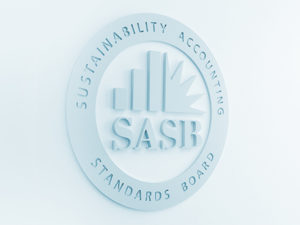
Amanda Medress, Director of Global Communications, SASB
In November 2020, the International Integrated Reporting Council (IIRC) and SASB announced our intention to merge into a unified organisation, the Value Reporting Foundation, in mid-2021. Since then, we have received many good questions about the purpose of and plans for this merger. Please see answers to your most frequently asked questions below.
What is the purpose of the Value Reporting Foundation?
The purpose of the Value Reporting Foundation is to merge SASB and IIRC into a credible, international organisation that maintains the integrated reporting framework, advocates integrated thinking, and sets sustainability disclosure standards for enterprise value creation. It is a major advancement towards building a more comprehensive and coherent corporate reporting system.
In an era where the impacts of global pandemic, climate change and growing inequality are intensifying, the concepts of sustainability and intangible value have grown in importance. Capital markets must evolve to deliver long-term value to shareholders while also helping secure the future of our people and our planet—improving reporting is an important means to this end.
How do the <IR> Framework and SASB Standards fit together?
The <IR> Framework and the SASB Standards are complementary tools for investor-focused communications. Together, the <IR> Framework and SASB Standards provide a more complete picture of long-term value creation while meeting investor needs for comparable, consistent, and reliable information. Much of the complementarity of the <IR> Framework and SASB Standards can be attributed to the inherent purpose of “frameworks” and “standards” for disclosure. Frameworks provide a set of (often) industry agnostic, principles-based guidance for how information is structured and prepared and which broad topics are covered. Standards offer industry-specific, replicable and detailed requirements for what should be reported for each topic.
The <IR> Framework provides principles-based guidance for reporting structure and content, while SASB Standards provide specific metrics to help understand non-financial risks and opportunities in greater detail. When used together, integrated reporting creates the connectivity needed to understand the relationship between non-financial and financial performance, while SASB Standards enable the comparability and accountability needed to accurately assess the effectiveness of a company’s governance, strategic planning, and risk management.
Is this a signal to report preparers that they should do both <IR> Framework and the SASB Standards?
The International <IR> Framework and SASB Standards will remain complementary tools.
While the Value Reporting Foundation will provide guidance on how to use both together, we expect organisations to use the standards and/or frameworks best suited to their needs to fulfil demands for transparent, robust reporting to a broad range of stakeholders.
Will there be changes to SASB Standards or how they are set?
No. SASB Standards will continue to be set according to the principles, processes, and practices outlined in the SASB Conceptual Framework and Rules of Procedure. The SASB Standards Board—an independent board that is accountable for the due process, outcomes, and ratification of the SASB Standards—will continue to play the same role.
Is the IIRC becoming a standard setter?
No, we have been clear on the role of the <IR> Framework as the connector that drives holistic and connected reporting across sustainability disclosure and financial and other capital reporting.
It will continue to as a principles-based disclosure framework that supports effective communication and reporting on strategy, governance, performance and prospects. The SASB Standards serve as a complementary tool to the <IR> Framework, providing disclosure guidance for sustainability topics connected to enterprise value creation. The conceptual underpinnings of the <IR> Framework’s six capitals and the SASB Standards’ five sustainability dimensions are already well aligned, and under the Value Reporting Foundation, we will link the concepts between the <IR> Framework and SASB Standards even further.
What will be the governance and leadership at the point of merger, and how will it develop?
The merged organisation will be governed by the Value Reporting Foundation Board, which will be chaired by Robert Steel and Richard Sexton, with Mary Schapiro and Helen Brand serving as Vice-Chairs.
An <IR> Framework Board will be formed to propose changes to the <IR> Framework, and the SASB Standards Board will continue to have delegated authority for the process and content of the SASB Standards.
The Value Reporting Foundation Board of Directors will be complemented by existing advisory bodies including the <IR> Business Network, the <IR> Council, the SASB Investor Advisory Group, and the SASB Standards Advisory Group.
Janine Guillot will serve as CEO of the Value Reporting Foundation, with Charles Tilley initially serving as Senior Advisor to support the integration of the two organisations. He will serve on the Foundation Board and chair the <IR> Framework Committee within the Board.
How does this fit with the work SASB already announced with GRI?
There are simultaneous and complementary projects underway to clarify the corporate reporting landscape. Earlier this year, SASB and GRI announced a joint workplan to make it easier for companies to use both sets of standards together. A technical report providing guidance is planned to be published in December.
The IIRC fully supports and encourages the collaboration between GRI and SASB. GRI’s standards are the leading standards for sustainability reporting to multiple stakeholders, and SASB and GRI continue to be committed to improving the interoperability of the SASB and GRI standards.
their impacts on the economy, environment and people—so that companies can improve efficiency by using information for multiple purposes. (SASB and GRI have already started a joint workplan designed to help companies use both sets of standards more easily.)
How does this fit with the CDP, CDSB, GRI, IIRC and SASB joint statement produced earlier this year?
The merger will advance the concepts CDP, CDSB, GRI, IIRC and SASB set out in their Statement of Intent To Work Together Towards Comprehensive Corporate Reporting, which outlines a vision for a comprehensive corporate reporting system. By integrating two entities that are focused on enterprise value creation, this merger represents significant progress towards simplifying the corporate reporting landscape. The Value Reporting Foundation could eventually integrate other entities focused on enterprise value creation, and the Foundation and CDSB have jointly signalled interest in entering into exploratory discussions in the coming months. The Value Reporting Foundation will continue working towards the joint vision outlined in the Statement of Intent.
How does this fit in with the IFRS Trustees consultation?
By merging two organisations focused on enterprise value creation, we hope to simplify the field. We support the IFRS Trustees consultation and are ready to engage with the IFRS Foundation, IOSCO and others working towards global alignment on a corporate reporting system.
How does this fit in with the European Commission and the European Financial Reporting Advisory Group work?
The IIRC and SASB are supportive of all efforts to advance progress towards a global comprehensive corporate reporting system. We believe that the work of the European Commission and EFRAG has the potential to make Europe a global leader in reporting, which can improve the quality of reporting internationally. We therefore continue to support their work and offer our intellectual capital as a resource. We have signed a memorandum of cooperation with EFRAG. We encourage leveraging existing frameworks and standards through a building block approach that can ensure global consistency for the capital markets while enabling flexibility to meet the needs of specific regions.
For a full list of FAQs, please click here.

